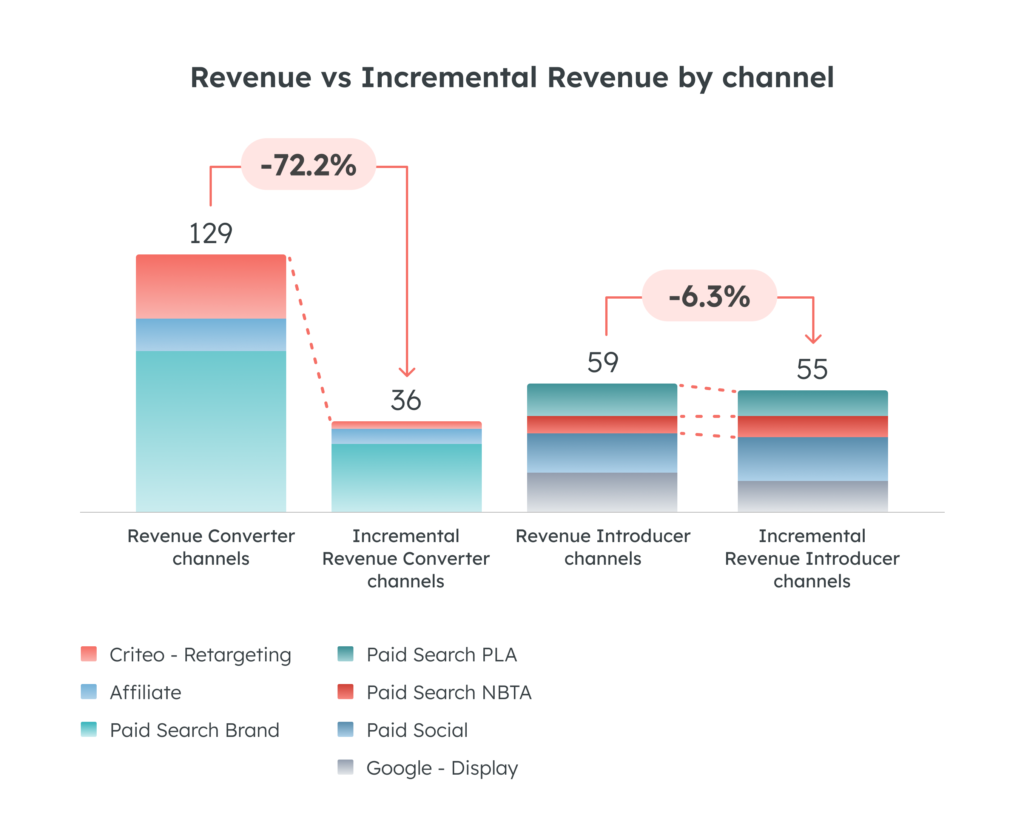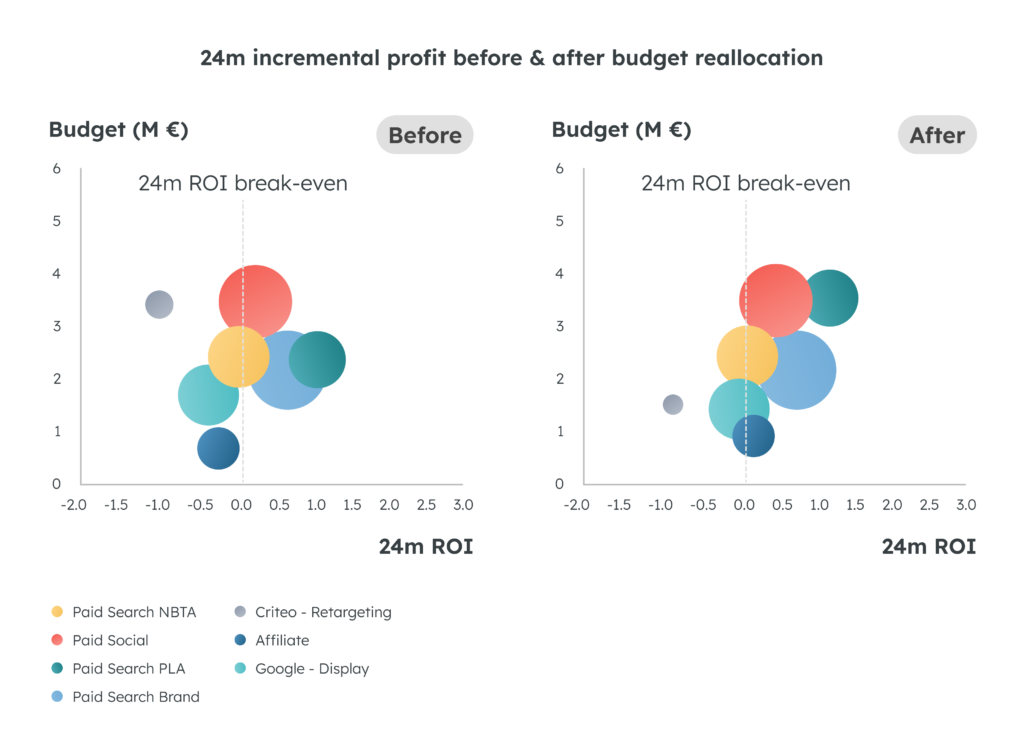Auditing the marketing spend for a mid-luxury fashion brand, in collaboration with our Management Consulting partner.
Can you imagine if you discovered that one of your e-commerce clients spent €5.3M of last year’s paid marketing budget targeting existing customers who would have bought without seeing ads? A massive waste and huge opportunity for improvement.
This is exactly what happened to one of our recent clients, Retailer X. We looked into their marketing spend with our Management Consulting partner and discovered that they’d spent most of their annual paid marketing budget (€5.3M) on channels that didn’t deliver any incremental revenue. How did this happen?
Avoid confusing high ROAS with high performance
For years, Return on Ad Spend (ROAS) has been the primary KPI that Performance Marketers use for decision making (and maybe your clients do too). Many opt to distribute marketing spend across audiences or channels that yield the highest revenue.
This strategy is not entirely wrong, but it is short-sighted. Why? Well, in addition to not factoring in margin and return rates, it fails to account for two other important factors that affect the profitability of a business. These factors are incrementality and new customer growth.
1. The importance of incrementality
Incrementality in Performance Marketing is a measurement of the true impact of your marketing activities, looking at how your business goal (e.g. purchase, revenue, profit, etc.) may be impacted with or without those activities. Even when a paid channel, let’s say Criteo – Retargeting, is generating high revenue at a high ROAS, it might not be adding value to your business. The reason is that Retargeting audiences have interacted with your brand before. These customers would tend to buy directly on your website or convert through Organic Search. As a result, ads that target these audiences will not influence their buying decision. In the above case of Criteo – Retargeting, revenue is not incremental.
Often enough, Criteo – Retargeting and Branded Text Ads are low in incremental value as they attract buyers at the end of a customer journey, who already know your brand. A business can significantly improve profitability by not investing so heavily in Criteo – Retargeting, and instead, shifting money into channels with higher incremental value such as Paid Search Product Listing Ads (PLA) or Paid Social. These channels can generate conversions that would not happen otherwise.
Channels like Paid Social and Paid Search PLA are, on the other hand, highly incremental. They reach users who aren’t aware of your brand yet. A user might type in a generic keyword such as “dresses online” without a specific shop in mind. If this person clicks on one of your ads and makes a purchase, this purchase is incremental to your business as it wouldn’t have happened if the user hadn’t seen the ad from this particular channel.
2. The importance of measuring new customer growth
Measuring new customer growth is crucial for maximizing long-term profitability in Performance Marketing because the share of new customers differs significantly across channels. By factoring in the predicted future profits of these new customers, the business can understand the contribution of each channel on profitability, ensuring a healthy customer base. Incrementality is directly linked to the measurement of new customer growth, in the sense that:
- Low-incrementality channels often attract low-funnel audiences who are already familiar with the brand. Therefore, these channels tend to have a low new customer rate.
- High-incrementality channels aim to turn new audiences with little to no touchpoints with your business into customers in the long run. As a result, they often have a high new customer rate and are the source of growth and long-term profitability in Performance Marketing.
Consequences of neglecting incrementality and new customer growth in your KPIs
Many of the 60+ e-commerce clients we work with globally have started out with a ROAS-centric mindset that has caused an over-focus on already loyal customers and channels with low incrementality. This not only exhausts valuable resources on existing customers but can also block ambitious expansion plans.
Let’s say you want to kick off your Performance Marketing activities in a new market but are eager to see immediate revenue at a decent ROAS, so you invest heavily in channels that are known to drive good ROAS, looking at historical data from existing markets. This practice can slow down the market growth as you send ads to those that are prompted to buy, not those that have not heard of you yet.
A better strategy for growth is prioritizing channels with high incrementality first to access their huge pool of new customers. ROAS might not be as high as in existing markets. However, you can reach new customers right at the start of their customer journey and can always guide them down the funnel later across all Performance Marketing activities. This will drive long-term growth and profitability.
All in all, while it is important to maintain a loyal customer base, Performance Marketing should focus on adding new customers to the mix to maintain business growth and profitability. Not just any new customers, but the most valuable ones should be acquired. Companies should target customers that come back over time and provide a healthy margin contribution to the business over their lifetime, thereby impacting the EBITDA of the business.
Unlocking profitability and new customer growth for a global fashion retailer
Let’s revisit our recent client, Retailer X, who has used our Opportunity Audit to solidify their Performance Marketing strategy. Their goal was to grow their customer base and expand into new markets.
Profile: Mid-luxury fashion brand, with global presence across North America, Europe, and Asia.
Current situation:
- Over-investment (34% of budget) in channels with low new customer rate.
- Over-investment (50% of budget) in their most saturated market instead of growing smaller, highly profitable markets with large new customer pools.
- This was the result of ROAS-centric mindset that has prevailed in the business for almost a decade.
A deep-dive into their Performance Marketing activity revealed the following:
Channel status quo:

- From the chart above (left side), we can see that Converter channels like Paid Search Brand, Criteo – Retargeting, and Affiliate indicated high conversion rates and high ROAS.
- However, these 3 channels were attracting buyers towards the end of their journey, generating orders that could have been picked up by unpaid channels such as SEO and Direct.
- This means that 72.2% or €36M of the total revenue from these three channels would have been generated by un-paid channels and shouldn’t be attributed to the paid channels when evaluating their profitability.
- The right side of the chart shows that channels such as Paid Search PLA and Paid Social had a significantly higher new customer share and reached potential clients further up in the funnel.
- Out of the €59M in generated revenue, €55M is incremental – the business wouldn’t have generated this revenue without activity in these channels.
- Out of the €59M in generated revenue, €55M is incremental – the business wouldn’t have generated this revenue without activity in these channels.
- Acquire more new customers for profitable growth in Performance Marketing
After the Opportunity Audit, we identified that re-allocating budget across channels and markets was an immediate opportunity for the client to drive profitable growth.
Budget re-allocation – Impact on channel profitability

First-order ROI: Return on Investment from first-order incremental revenue
24m ROI: Return on Investment from 24-month incremental revenue
*Budgeting decisions were made based on ROIs of each channel.
Our Marketing Analytics team recommended:
- Increasing budget for Paid Search PLA (+61%), Affiliate (+32%), Paid Search NBTA (Non-Branded Text Ads) (+8%), and Paid Social (+4%).
- Pulling back for Criteo – Retargeting (-53%) and Google – Display (-14%).
The results:
- A big opportunity to increase Paid Social and Affiliate profitability. With our recommendations, the client’s 24-month ROI could be improved by 233% and 132%, adding incremental profits of €4M and €2.4M, respectively.
- Paid Search PLA 24-month ROI could be improved by 15%, adding €5.8M in incremental profit.
- Paid Search NBTA was shifted from losing money to break-even, with a 67% better 24-month ROI and €448K increase in incremental profit.
- Criteo – Retargeting, on the other hand, remained unprofitable due to very low incremental value. We recommended a set of operational fixes for Criteo – Retargeting and Paid Search NBTA for the client to immediately increase efficiency but also incremental profitability.
- Altogether, the re-allocation strategy lifted total incremental profit by €17.6M at a 10x better ROI globally for Retailer X.
Conclusion – How can you get better results by focusing on incrementality and new customers?
To refer back to the original question of this article, we can see that ROAS can only take you so far. However, by reallocating budget towards more incremental channels and evaluating ROI, you can likely add millions in incremental revenue and gain more exposure to new customers. Instead of reactively clinging to sales in the short run, you can now drive sustainable profitable growth with your Performance Marketing.
By evaluating the potential of integrating first-party data into bidding and applying an incrementality-based attribution model in our calculations, within only 3 weeks, we were able to develop a much needed budget reallocation strategy that significantly improved ROI for Retailer X. Curious how you can benefit? Learn more about our Opportunity Audit.




